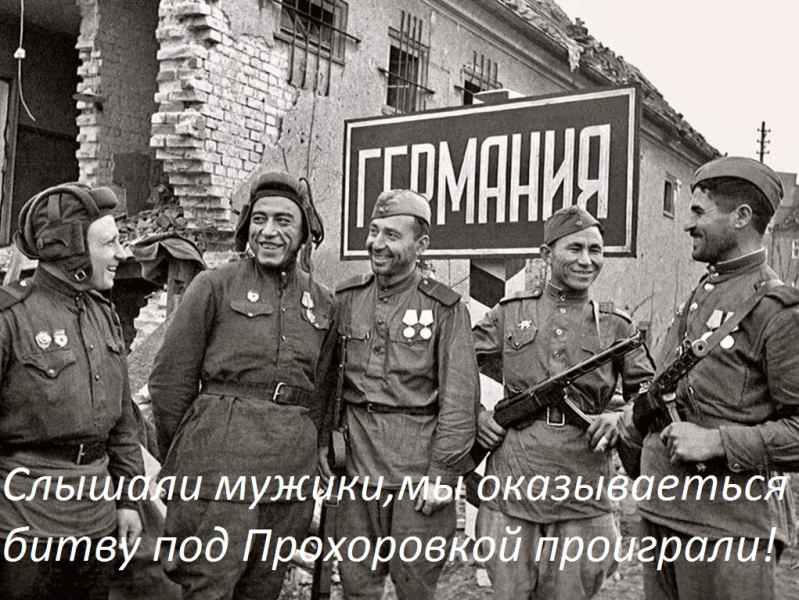Portal warfiles.ru analyzes the opportunities the Super American. This non-nuclear multi-ton bunker bomb GBU-57 is designed for severe attacks by B-2 bomber.
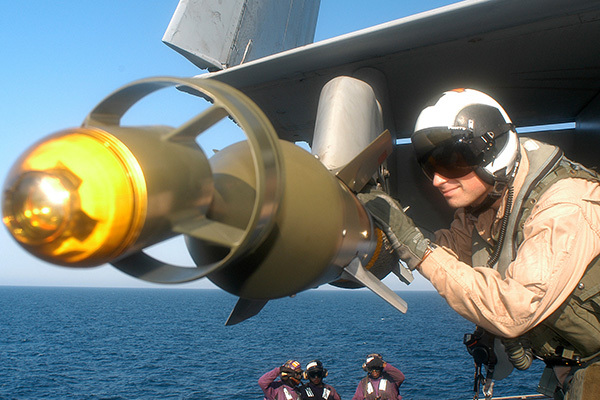
Nevskii-bastion.ru website gives details of the history of creation and modernization of another unfinished American “super-weapons”. The Boeing Company expects the contract on reconstruction of 13.6-ton non-nuclear bomb penetrating GBU-57 Massive Ordonance Penetrator (MOP), According flightglobal.com 15 October (photo – dropped a bomb on board the B-52 above the polygon White Sands in 2009 year – ca.. military Parity). The program was designated Enhanced Threat Reduction IV. bomb development began in 2004 year, but mass production was deployed.
Redesign of GBU-57 and serial production can take at least six years, but there is the possibility of adopting similar purpose bomb BLU-127. Military Parity bunker busters MOP GBU-57A / B Massive Ordnance Penetrator Development (MOP) It began in the US 2002 year. Internal components of the bomb created a US company Northrop Grumman and Lockheed Martin, while Boeing engaged in the design and testing of the munition shell.
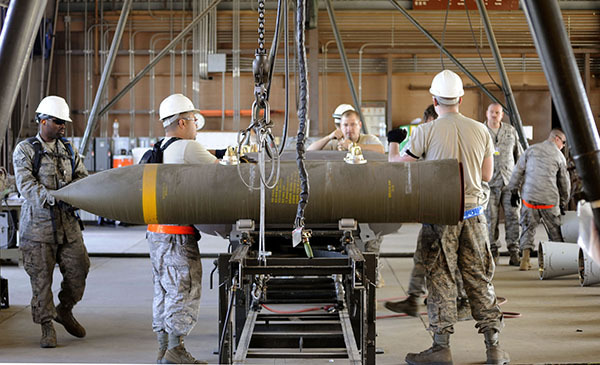
Af.mil
Now the US Air Force are about 20 bombs. Boeing is engaged in the production of the company.
The total value for their creation of the program is estimated at 330 millions of dollars. It is believed, that MPAs is a "backup plan" US contingency complications, related to the development of Iran's nuclear program. Carry such bombs can bombers B-1B Lancer and B-52 Stratofortress US Air Force.
The basic version of MOP was able to break through 60,9 meters of concrete, before, exploding. New features of penetration bombs after its modernization, not yet known. MOP warhead has a mass of about 2,5 tons.
Air Force expects to receive the first MOP adopted next year. In recent years, several B-2 bombers were equipped to carry this type of weapons (two bombs on the B-2). it, obviously, It is a certain kind of message to Iran and North Korea. unknown, who in addition to Iran and North Korea, it can be addressed.
The history of the super-bomb examines in detail an interesting article from a magazine “Popular mechanics”. At the time of Iraq's army entry into Kuwait and started the preparation of the American shares of the most "advanced" in the US Air Force bunker warhead was BLU-109 (Bomb Live Unit). This warhead casing had a thickness of a steel alloy 25 mm, who filled 240 kg of explosives (trytonala). BLU-109 was used in GBU-24 aerial bombs (for the F-111 Aardvark and F-15E) and GBU-27 with laser guidance system Paveway III (for F 117A), and in bombs GBU-15 electro-optical guidance and in missiles (actually guided bombs with a rocket engine) AGM-130. This thing could break some meter layer of steel reinforced concrete, and then, thanks to the electromechanical fuse, TRITONAL erode and destroy the contents of the charge bunker.
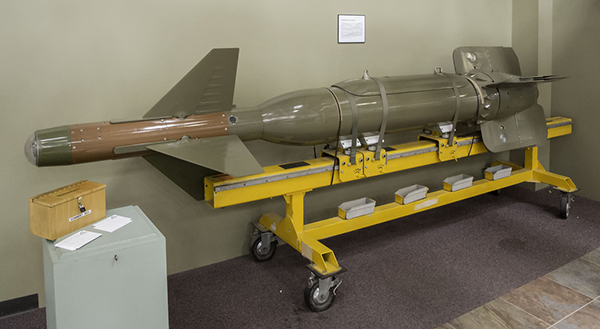
However, Saddam Hussein was, looks like, in the course of American weapons capabilities: He dug and concreted its strategically important objects as, BLU-109 that they were too tough. exploration has reported, Iraqi bunkers to shelter troops and command and control centers is an extensive system of tubular passages, that connected rooms for different purposes. All of this was placed under a 15-m layer of soil and a reinforced concrete slab thickness 60 cm. non-nuclear weapons, which would have enough energy to overcome a two-layer protection, Americans at that time were not.
In this situation, Thomas Ferguson, one of the senior officials of the US Air Force, in October 1990 year instructed the design units ASD Development Planning group, located on the Air Force Base Eglin (Florida), urgently prepare a proposal for the creation of weapons, capable Dotyanutsya Saddam underground bunkers. To the project engineers also hooked Lockheed Missile and Space Company.
Exit prompted former army officer, worked for Lockheed. He remembered, that somewhere in storage should be kept written off howitzer guns M201 SP. They have just been actuated alloy, ydentychnoho ago, of which they were manufactured and bows BLU-109. The trunks were found in the warehouses of several artillery arsenals, in particular in the Watervliet Arsenal (New York). It is in this arsenal workshops barrels were refined to the desired settings. They are cut to fit the specified size, We removed all protruding elements from the outer surface. Inside trunks drilled the hole to a diameter 10 inches (254 mm), to a new "body" bombs it could be tight fitting tip of the BLU-109.
From Watervliet Arsenal collected body once again brought to the Eglin base, where they were to be charged. of course, No special equipment for the bomb of this size at the airbase was not, and I had to work almost artisanal methods. In particular, insulating layer, which is deposited on the inner surface of the housing, I had to undergo a heat treatment in a special oven, however, instead of the furnace engineers have been forced to use an external electric homemade. Manually, dug housing vertically into the ground, in a bomb filled buckets hot molten TRITONAL. For guidance system used a laser sighting device on the GBU-24. The resulting warhead eventually became known as the BLU-113, a bomb, made on its basis, – GBU-28.
Since time is running out, instead of the 30 test launches were limited to only two. 24 February 1991 , the bomb was dropped from an F-111 on a desert firing range. GBU-28 went into the ground at 30 m – with the depth it decided not to dig. Two days later, a bomb run on a jet truck and rail shot on the upright standing pile of concrete slabs. The projectile struck all plates and a further fall 400 m.
Another two buildings, Eglin Air Force Base made, They were charged, equipped and sent directly to Iraq. Using the complete domination of American aircraft in the air, 23 February 1991 , two F-111 without incident reached the goal – one of the underground bunkers of the Iraqi army. While one bomber illuminated target using LPC devices, others go on bombing. One bomb went past, making the probability of success of the test is only 50 per cent. But another flew right on target, without leaving any visible traces of impact on the surface. Only seven seconds later from the ventilation shafts of the hopper thick smoke, that could only mean one thing – hopper struck and burned to ashes. On the task before the powerful bunker busters GBU-28 has passed only four months.
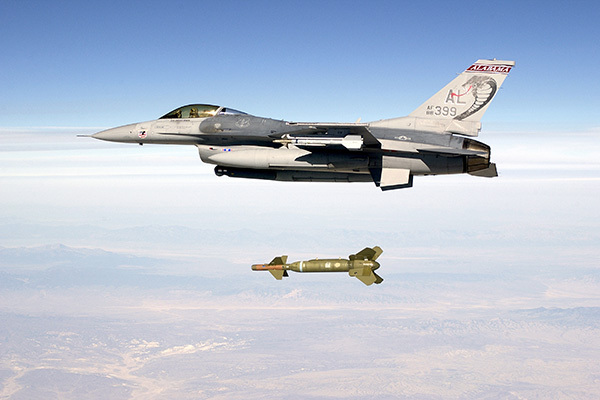
In the fighting in Yugoslavia (Operation Soyuznaya sila ') US Air Force used a "perspective unitary penetrating" (English abbreviation AUP) warhead BLU-116. In size it corresponded exactly to the good old BLU-109, However, the shell, probyvayuschyy concrete, had smaller caliber. At the same time he was imprisoned in larger diameter casing- aluminum alloy. For the manufacture of the "rod" used hard alloy steel, nickel and cobalt brands 9430 M. Warhead BLU-116 was used as part of a laser-guided bombs with GBU-24, C / B and GBU-24 D / B. the main thing, that featured a new generation of missile, – is the ability to penetrate through the thick concrete barriers to 6 m, what is not less important, ability to work with complex design of concrete structures. BLU-116 was equipped with HTSF (FMU-157D) – the so-called smart fuze for hard targets. Due to the installed sensors and microprocessor fuse is able to "count the floors", which is perceived as a sequence of overcoming obstacles and voids. In this way, bomb can be programmed, that it has implemented the undermining of explosives at a particular level concrete bunker.







